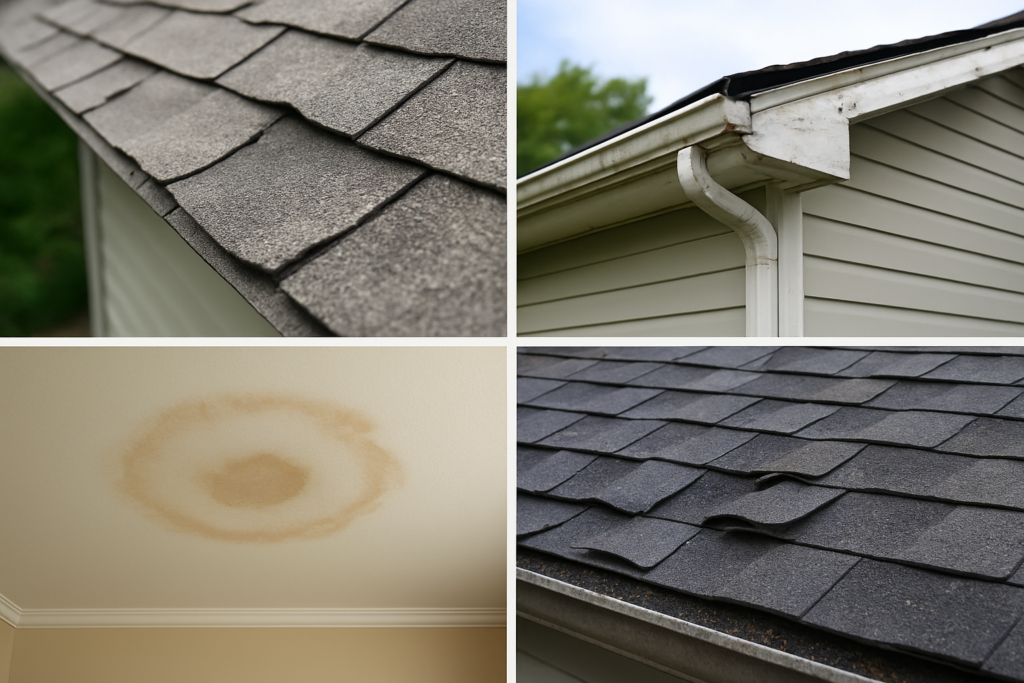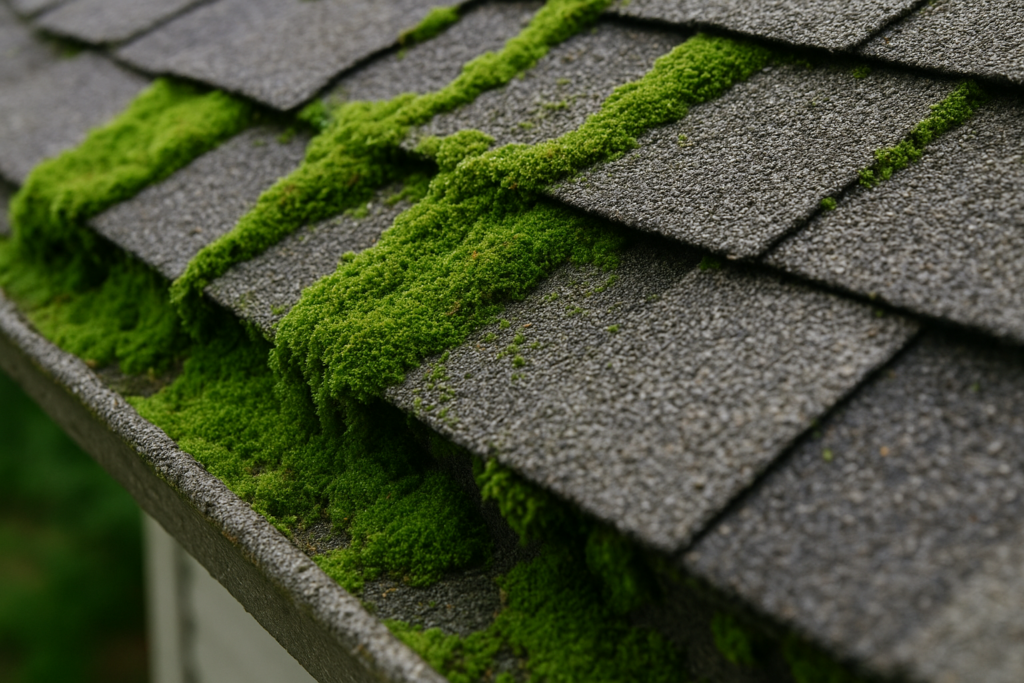11April 2025
Key Takeaways
- Moss, algae, and roof stains can cause serious damage beyond cosmetic issues.
- Signs include dark streaks, green patches, curling shingles, and water stains inside your home.
- New Jersey’s climate makes roofs more susceptible to moss and algae growth.
- Routine roof inspections and maintenance can prevent costly repairs.
- T.A. Hughes Roofing offers expert inspections and safe roof cleaning services in NJ.
Why That Roof Stain Might Be a Bigger Problem Than You Think
You might glance at your roof, notice dark streaks or green patches, and think, “It’s just dirt or mildew.” Unfortunately, that assumption could cost you thousands in repairs. Moss, algae, and roof stains are more than unsightly—they’re often signs of hidden roof damage.
For New Jersey homeowners, where humidity and seasonal storms are common, these issues can escalate quickly. Left untreated, they lead to leaks, rotting wood, and even structural damage.
If you’ve noticed discoloration on your roof, don’t ignore it. T.A. Hughes Roofing is here to help with expert roof inspections and maintenance services tailored to New Jersey’s climate.
What Are Moss, Algae, and Roof Stains?
Understanding what’s growing on your roof is the first step toward solving the problem.
Moss:
- A green, spongy plant that thrives in damp, shaded areas.
- Grows in thick clumps between shingles, trapping moisture.
- Common on roofs with poor sunlight exposure.
Algae (Gloeocapsa Magma):
- Causes black or dark green streaks on roofs, often mistaken for dirt.
- Feeds on the limestone in asphalt shingles, which are common in NJ homes.
- Spreads quickly in humid climates.
Roof Stains:
- Discoloration caused by algae, mold, mildew, dirt buildup, or water damage.
- Can be brown, black, or green and often spread over time.
Learn more about other common issues in The Most Common Roofing Issues in South Jersey Homes (And How to Prevent Them).
Are Moss, Algae, and Roof Stains Damaging Your Roof?
Yes—these growths can cause significant damage if left untreated.
How Moss Damages Your Roof:
- Traps Moisture: Moss acts like a sponge, holding water against your roof.
- Lifts Shingles: As moss grows, it pushes shingles apart, letting water seep in.
- Leads to Rot: Moisture causes wood rot and weakens the roof’s structure.
The Hidden Threat of Algae:
- Erodes Shingles: Algae breaks down the protective layer of shingles.
- Increases Energy Costs: Dark streaks absorb heat, raising cooling bills in the summer.
Roof Stains as Red Flags:
- Water Damage Indicator: Stains often signal leaks or poor drainage.
- Mold Growth: Prolonged moisture fosters mold, which can affect indoor air quality.
Don’t wait for damage to escalate. Learn about the risks in The Real Cost of Neglecting Roof Maintenance in New Jersey.
Why Does This Happen to NJ Homes?
Climate Factors:
- High Humidity: NJ summers create the perfect environment for moss and algae growth.
- Frequent Rain: Leads to consistent moisture buildup.
- Seasonal Changes: Freeze-thaw cycles in winter can worsen roof damage.
Roof Orientation:
- North-Facing Roofs: Receive less sunlight, staying damp longer.
- Shaded Areas: Overhanging trees trap moisture, encouraging growth.
Poor Ventilation:
Without proper airflow, trapped moisture leads to mold, algae, and moss problems.
Stay prepared for seasonal changes with The Ultimate Guide to Protecting Your Roof in South Jersey.
Signs It’s More Than Just a Cosmetic Issue
Exterior Red Flags:
- Curling or Cracked Shingles: Indicate moisture damage.
- Sagging Roofline: A sign of potential structural issues.
- Granule Loss: Check gutters for asphalt granules, a sign of deteriorating shingles.
Interior Warning Signs:
- Water Stains on Ceilings or Walls: A clear sign of roof leaks.
- Mold or Mildew in the Attic: Indicates prolonged moisture exposure.
- Higher Energy Bills: Damaged roofs reduce insulation efficiency, increasing heating and cooling costs.
Identify hidden damage with Professional Roof Inspection in New Jersey.

DIY Roof Cleaning vs. Professional Help
Risks of DIY Cleaning:
- Safety Hazards: Roof work increases the risk of falls.
- Potential Damage: Power washing can strip protective layers from shingles.
- Ineffective Solutions: Without the right chemicals, moss and algae grow back quickly.
When to Call a Professional:
- Widespread moss or algae growth
- Visible damage to shingles
- Signs of leaks inside your home
Protect your roof with expert care from The Best Roofing Contractors in New Jersey.
How to Prevent Moss, Algae, and Roof Stains
Simple Prevention Tips:
- Schedule Regular Roof Inspections: At least once a year, and after major storms.
- Trim Overhanging Trees: Reduces shade and moisture buildup.
- Clean Gutters Regularly: Prevents water from pooling on your roof.
- Install Zinc or Copper Strips: Natural deterrents for moss and algae growth.
For a full checklist, visit The Ultimate Roof Maintenance Checklist for NJ Homeowners.
The Cost of Ignoring the Problem
| Issue | Cost if Caught Early | Cost if Ignored |
| Minor Cleaning | $150–$300 | N/A |
| Moderate Repairs | $500–$1,500 | $5,000–$10,000 |
| Full Roof Replacement | N/A | $8,000–$15,000+ |
Discover cost-saving tips in The 2024 Guide to Roof Replacement Costs in South Jersey.
Real-Life Story: How T.A. Hughes Saved a NJ Homeowner Thousands
“A Gloucester County homeowner noticed dark streaks on their roof. They called T.A. Hughes for an inspection, and we discovered hidden moss growth lifting the shingles. A $350 cleaning saved them from a $9,000 roof replacement.”
See more success stories in Testimonials.
Frequently Asked Questions (FAQs)
1. How do I know if moss is damaging my roof?
If you see green patches lifting shingles or water stains indoors, it’s time to call a professional.
2. Is it safe to remove roof algae myself?
Not recommended. DIY methods can damage shingles and create safety risks.
3. Does insurance cover roof damage from moss or algae?
It depends on your policy, but many don’t cover damage from neglect.
4. How often should I have my roof inspected?
At least once a year, and after major storms.
Learn more about roof care in How to Extend the Life of Your Roof in Gloucester County, NJ.
Why Choose T.A. Hughes for Roof Cleaning & Inspections in NJ?
- 35+ Years of Roofing Experience
- Certified, Licensed Roofing Professionals
- Free Roof Inspections and Estimates
- Safe, Eco-Friendly Cleaning Techniques
Compare contractors in Gloucester County or Camden County.
Protect Your Roof Before It’s Too Late

Moss, algae, and roof stains aren’t just cosmetic—they’re early warning signs of potential damage. Ignoring them can lead to costly repairs, energy loss, and structural damage.
Schedule a Free Roof Inspection with T.A. Hughes today to protect your home from hidden threats.
